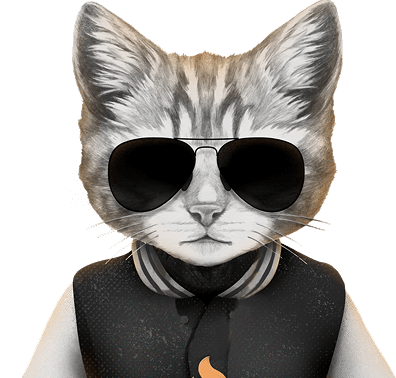
Content creators, brand ambassadors, or key opinion leaders. What do they have in common? They are influential people who have gained recognition in their field and built a loyal following around their content.
Advertising with renowned people isn’t a recent development, but it has changed over the years and shifted to social media channels, blogs, and podcasts. To keep up with these challenges, numerous businesses are putting their trust in social media influencers, thus making influencer marketing a staple element of their marketing strategies.
Influencers can be categorized in several ways, and companies must choose the right creators accordingly. But what is the difference between various types of influencers? And how can brands identify influencers that align with their values and budget?
We created this article to introduce you to the diverse categorizations of influencers and to help you understand what nano-, micro-, mega-, or virtual influencers are. Keep reading and get to know various influencer types and their benefits!
Nano-influencers
 In terms of size, nano-influencers are the smallest of the bunch with a follower number of 1000-10,000. They may be very niche influencers with a narrow audience, or your everyday user whose content has taken off. They are approachable, genuine, or simply create content in a specific geographical area. Their content is not necessarily polished, but they are knowledgeable about a topic, making them relatable and authentic.
In terms of size, nano-influencers are the smallest of the bunch with a follower number of 1000-10,000. They may be very niche influencers with a narrow audience, or your everyday user whose content has taken off. They are approachable, genuine, or simply create content in a specific geographical area. Their content is not necessarily polished, but they are knowledgeable about a topic, making them relatable and authentic.
What they lack in size and reach they make up for in engagement. According to our State of Influencer Marketing 2025 report, in 2024, nano-influencers on TikTok produced a whopping 10.3% ER and 1.73% on Instagram. Better yet, more than 63% of Instagram creators and almost 67% of TikTok creators are nano-influencers.
So, if brands choose to work with them, they can even team up with multiple nano-influencers within a single influencer campaign. Through nano-influencers, businesses can reach niche audiences more successfully, engage them more effectively, and still be better off financially than with fewer but more popular influencers.
If you want to do a quick check on a nano-influencer's or any influencer's engagement rate, you can try our Instagram ER calculator here:
Micro-influencers
 Previously, influencer marketing was all about the more the merrier, marginalizing creators with less than 50,000 followers. Since this criterion has been removed micro-influencers have become the new rising stars of influencer marketing. And how many followers do micro influencers have? Between 10,000-50,000.
Previously, influencer marketing was all about the more the merrier, marginalizing creators with less than 50,000 followers. Since this criterion has been removed micro-influencers have become the new rising stars of influencer marketing. And how many followers do micro influencers have? Between 10,000-50,000.
In recent years, many brands have discovered the benefits of working exclusively with macro-influencers or working together with them in campaigns that have already involved mega-influencers.
Most of these creators started out as regular social media users, steadily growing their follower base and reaching nano- and then micro-influencer status. Just like nano-influencers, they also connect with their followers on a deeper level and their small but devoted fan base pays attention to their thoughts. They gained authority on a specific subject and can captivate people’s attention with their original content.
Based on the size, micro-influencers make up the second biggest group on Instagram and TikTok. They generated the second-highest ER, 0.68% on Instagram and 8.7% on TikTok in 2024. Not to mention, they are still more affordable compared to celebrities.
What is the difference between nano and micro-influencers?
Both types of influencers have a smaller audience with whom they maintain a more intimate relationship and can effectively impact brands' influencer marketing campaigns. Still, they differ on several terms:
Audience size: A nano influencer has 1,000 to 10,000 followers, but can quickly grow into a micro influencer with an audience between 10,000 and 50,000 followers.
Engagement: Due to their strong connection with their relatively small audience, nano-influencers have the highest engagement rates on TikTok and Instagram. Micro-influencers have a slightly lower ER since they can’t form such a close relationship with their follower base.
Niche: Both nano- and micro-influencers are passionate about a niche, but micro-influencers create content on more general topics.
Genuineness and relatability: Nano-influencers are considered the most authentic and relatable since they foster an intimate connection with their followers.
It goes without saying that nano- and micro-influencer collaborations are on the rise. They are affordable and have an engaged fan base. Many brands have realized they can target distinct audiences and improve brand reputation considerably better with them. However, before you reach out to them, think about your marketing goals and whether these creators can truly help you achieve them.
Mid-tier Influencers
 Some mid-tier influencers may have begun as nano-influencers and gradually grew their followers to 50,000-500,000. They already have a lot of experience in content creation and in brand collaboration as well, thus they’re pricier. Their influencer content is professional, yet authentic enough to engage people. A mid-tier influencer's connection with their audience is less personal, but they have a much larger reach and produce 0.54% ER on Instagram and 7.5% on TikTok.
Some mid-tier influencers may have begun as nano-influencers and gradually grew their followers to 50,000-500,000. They already have a lot of experience in content creation and in brand collaboration as well, thus they’re pricier. Their influencer content is professional, yet authentic enough to engage people. A mid-tier influencer's connection with their audience is less personal, but they have a much larger reach and produce 0.54% ER on Instagram and 7.5% on TikTok.
Macro-influencers
 Their audience is between 500,000 and 1 million. They either became popular on the social media channel they are active on or established their reputation on TV or other channels before they joined social networks. Having many followers means a higher reach and a higher price, so businesses with a tighter budget may not afford them. Not to mention that these creators are considered less relatable than micro-influencers.
Their audience is between 500,000 and 1 million. They either became popular on the social media channel they are active on or established their reputation on TV or other channels before they joined social networks. Having many followers means a higher reach and a higher price, so businesses with a tighter budget may not afford them. Not to mention that these creators are considered less relatable than micro-influencers.
Many macro-influencers share content on diverse topics and don’t necessarily focus on a narrow niche. Even if they are industry experts with a large following, they may not produce the engagement rates expected by brands. As our report shows, their ER was the lowest of all types, with 0.61% on Instagram and 7.1% on TikTok. Nonetheless, they can successfully endorse new products for a large audience.
Mega-influencers
 The smallest influencer tier is the mega- and celebrity influencer, with a following of over 1 million users. Mega-influencers developed their celebrity status on social media. They are thought leaders, or entertainers, and have the widest reach. This attracts many businesses, however, mega-influencers usually create their own brand and products, thus it’s difficult to pique their interest in a collaboration.
The smallest influencer tier is the mega- and celebrity influencer, with a following of over 1 million users. Mega-influencers developed their celebrity status on social media. They are thought leaders, or entertainers, and have the widest reach. This attracts many businesses, however, mega-influencers usually create their own brand and products, thus it’s difficult to pique their interest in a collaboration.
Celebrity Influencers
 They were already renowned megastars, actors, athletes, models, or artists before they entered social media. They often are considered role models and have a huge following. Just like macro- and mega-influencers, they are often sought after by brands. Yet, celebrities are less approachable and relatable than nano- and micro-influencers.
They were already renowned megastars, actors, athletes, models, or artists before they entered social media. They often are considered role models and have a huge following. Just like macro- and mega-influencers, they are often sought after by brands. Yet, celebrities are less approachable and relatable than nano- and micro-influencers.
Mega- and celebrity influencers have established careers and incomes and choose carefully whom they work with. Because they are the most expensive, brands need to consider longer partnerships, like brand ambassador programs, before reaching out to them. Due to their stardom, people eagerly watch them and engage with their content. Their engagement rate in 2024 were 0.68% on Instagram and 7.1% on TikTok.
Pros and cons of working with mega- and celebrity influencers
Needless to say, each influencer type and collaboration has its advantages and disadvantages. Now let’s see the pros and cons of working with celebrities and mega-influencers:
Benefits
Very high reach: This influencer type has the largest number of social media followers, hence the widest reach, which is ideal if businesses want to introduce a new product.
Brand awareness: Due to their massive fan base, they successfully increase brand recognition.
Credibility: People trust influencer recommendations more than traditional ads. Through these endorsements, people attribute a higher value to products and services.
Expertise: Celebrity influencers, like professional athletes, have a lot of knowledge about sports clothing, nutrition, and training that adds extra value to these promotions.
Drawbacks
Costs: Celebrity and mega-influencers charge high sums for publishing a sponsored post on their channel, making it impossible for businesses with low budgets to work with them.
Less authenticity: Big names can’t nurture a close relationship with their followers, thus they’re considered less authentic.
Negative image: A celebrity influencer’s negative public image and scandals can cast a bad light on a brand.
Low level of control: Businesses don’t have all the control over a mega- or celebrity influencer’s content, since they also have to take into account their reputation.
Scheduling: Due to their busy schedules, actors, models, and musicians are difficult to reach or won’t be available for collaboration.
Niche Influencers
 Creators passionate about a specific subject or narrow field within an industry are called niche influencers. They have a hyper-focused, small community of followers who regard their content highly. Their audience count is usually under 10,000, and they are considered the most genuine and relatable creators.
Creators passionate about a specific subject or narrow field within an industry are called niche influencers. They have a hyper-focused, small community of followers who regard their content highly. Their audience count is usually under 10,000, and they are considered the most genuine and relatable creators.
Niche influencers gained extensive knowledge on a subject and their content isn’t as sophisticated as macro-influencers. Their words carry weight among their followers, ensuring high levels of interaction and enabling brands to reach a more explicit audience.
Small creators don’t have much experience in brand collaborations, so businesses need to take more time to negotiate with them. As niche content creators are relatively inexpensive, businesses can work with several of them on one campaign offering a smaller one-time fee or free product samples.
Types of niche influencers
Typically, niche influencers cover a particular subject or a narrow topic within a broader industry. Here are the most common.
Lifestyle: What is a lifestyle influencer? Simply answered, anybody can be considered a lifestyle influencer who shares content about their lifestyle and daily routines. Although the topic is quite generic, many niche influencers focus only on food, outfit of the day, or day-in-the-life content.
Some popular lifestyle hashtags: #simpleandstill, #verilymoment, #ditl, #ootd.
Fashion: Creators posting about fashion tips, before-after ideas, recycling and remodeling of clothes, and apparel brands belong to fashion influencers.
A couple of fashion-related hashtags: #backtominimal, #trueoutfit, #bestofstreetwear, #simplefits.
Beauty: Influencers creating content linked to hair and skin care, make-up tutorials, product testing, and beauty products are included in this niche.
A few examples of beauty hashtags: #dressyourface, #beauty_features, #makeupart.
Gaming: They play online and stream their games through various platforms, like Twitch or upload them on YouTube. Gaming influencers might have built a large community of like-minded people and usually stick to advertising gaming-related brands and products.
Some gaming hashtags: #easports, #headset, #rog, #xbox.
Health and fitness: Personal trainers, and nutritionists promoting a healthy lifestyle, and workout routines, or everyday users sharing their fitness journey. These creators efficiently promote health and fitness-related products and services.
Popular health and fitness hashtags include #homeworkout, #balancedlife, #healthmotivation, and #fitnesstransformation.
Travel: These influencers share photos and opinions of their favorite destinations and hotels. Users can read their travel tips, dos, and don’ts, or just gather ideas for their next trips. With the rise of digital nomads, young professionals working and living on the road have joined the group of travel influencers as well.
Examples of travel hashtags: #solotraveller, #backpackerlife, #passportready, #vanlife.
Food: Food enthusiasts who publish recipe videos, food images, and favorite restaurants. Food influencers usually try out and collaborate with home delivery services and food and beverage brands.
Food hashtags include #foodlover, #eatthis, #dailyfoodfeed, and #beautifulcuisines.
Finance: Believe it or not, financial advisors also entered the world of social media and spread the word about money management tricks, investing tips, cryptocurrencies, financial discipline, and discuss banking and financial services.
A couple of financial hashtags: #blockchain, #FinancialPlanning, #DebtFree, #forex.
Pets: People passionate about animals and keeping pets share their images, tricks, and tips on pet care, products, and services.
Hashtags connected to animals and pets: #weeklyfluffy, #meow_beauties, #petoftoday.
Tech: They are up-to-date on tech industry news and product launches. Tech influencers regularly upload reviews about new gadgets and their opinions are respected by their community.
Some popular hashtags on the topic: #gadgets, #technews, #artificialintelligence, #coding.
Family: Parenting influencers providing content on parenting, family events, and venues for kids. Like the creators themselves, their audiences consist mostly of parents or young couples starting a family.
Parenting hashtags: #parenting101, #letthekids, #ohmamamoment, #vsco_mom.
Our list is far from complete. There are several niches and industries we haven’t covered, and influencers who are specialists in those subjects. Businesses should look around among the influencers active in their sector. Through these creators, they can target highly engaged audiences.
Virtual Influencers
 Influencers created by computers and endowed with a personality: virtual influencers. Agencies create them, often for the purpose of working with brands in marketing campaigns. Apart from shaping their personality and appearance, businesses can exercise more control over the content they post. Moreover, they are more affordable than celebrities and businesses don’t have to accommodate their schedules to theirs.
Influencers created by computers and endowed with a personality: virtual influencers. Agencies create them, often for the purpose of working with brands in marketing campaigns. Apart from shaping their personality and appearance, businesses can exercise more control over the content they post. Moreover, they are more affordable than celebrities and businesses don’t have to accommodate their schedules to theirs.
As virtual reality became more widespread, the popularity of virtual influencers grew as well. Numerous CGI influencers collaborate with brands regularly, although not always successful. Many people can’t identify with fictional or even non-human content creators and they are less likely to be experts on a topic. So businesses must assess whether they are losing rather than gaining by teaming up with them.
Benefits and Challenges of Working with Influencers
Now that you know the most important social media influencer types, let's review their benefits and challenges.
Advantages
Visibility and reach: Creators with a large following can help businesses increase visibility and reach.
Credibility and trust: Influencer product reviews and recommendations are considered more trustworthy by users. Through them, brands can build customer trust and maintain credibility.
Reach specific audiences: Businesses have a good shot at reaching highly curated audiences with key opinion leaders.
Affordable: Compared to traditional TV commercials and print media ads, influencer endorsements are cost-efficient. Influencer marketing is affordable to small businesses with a lower budget.
Challenges
Choosing the right influencers: It requires thorough research to identify creators who align with a brand’s values.
Communication and negotiation: Businesses must take the time and effort to build strong partnerships with creators and negotiate collaboration details to avoid misunderstandings.
Lack of control: It's common for mega-influencers and celebrities to guard their brand and reputation, meaning businesses have less control over the content they create.
Measuring campaign performance: Tracking and evaluating the success of an influencer marketing campaign to calculate the return on investment is laborious.
Of course, the benefits and challenges vary according to the company's expectations and the influencer's performance.
Final Thoughts
The influencer marketing industry is substantial. Authentic content from credible sources is in demand, and influencers can fulfill this need. It’s up to your business needs, industry, and budget which type of influencer will be the most suitable fit for you. However, they can give your social media presence a more personal touch, so it's worth adding them to your strategy.














